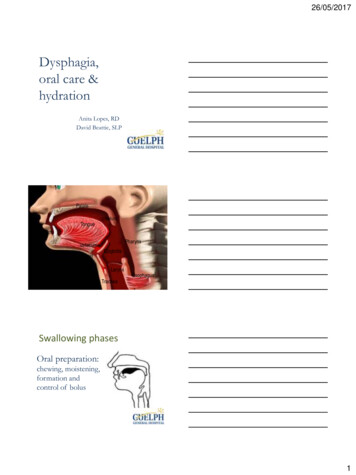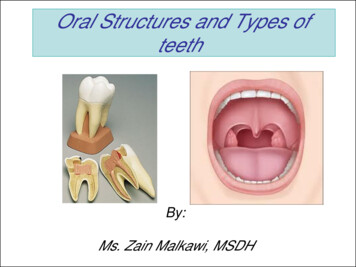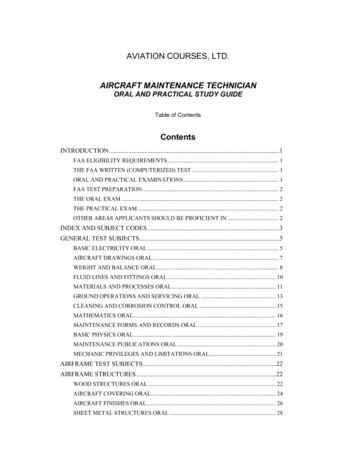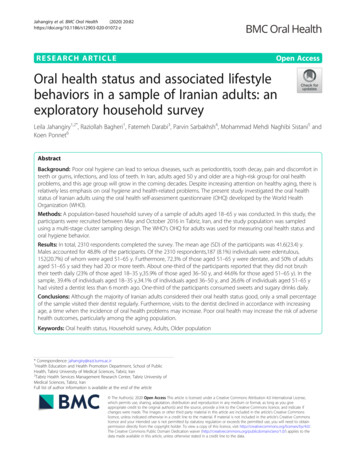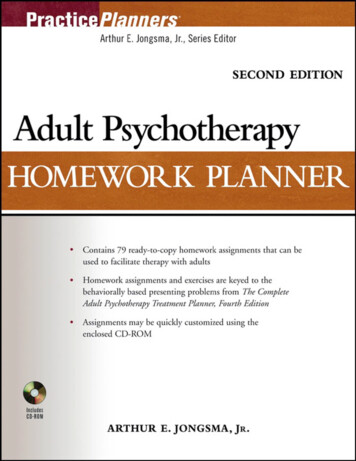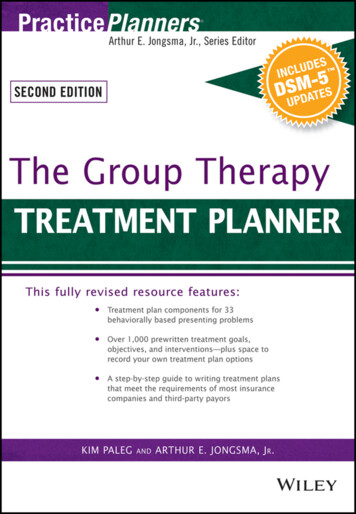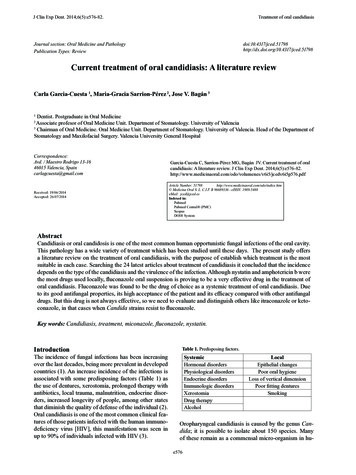
Transcription
J Clin Exp Dent. 2014;6(5):e576-82.Treatment of oral candidiasisJournal section: Oral Medicine and PathologyPublication Types: 317/jced.51798Current treatment of oral candidiasis: A literature reviewCarla Garcia-Cuesta 1, Maria-Gracia Sarrion-Pérez 2, Jose V. Bagán 3Dentist. Postgraduate in Oral MedicineAssociate profesor of Oral Medicine Unit. Department of Stomatology. University of Valencia3Chairman of Oral Medicine. Oral Medicine Unit. Department of Stomatology. University of Valencia. Head of the Department ofStomatology and Maxilofacial Surgery. Valencia University General Hospital12Correspondence:Avd. / Maestro Rodrigo 13-1646015 Valencia, Spaincarlagcuesta@gmail.comReceived: 19/06/2014Accepted: 26/07/2014Garcia-Cuesta C, Sarrion-Pérez MG, Bagán JV. Current treatment of oralcandidiasis: A literature review. J Clin Exp Dent. volumenes/v6i5/jcedv6i5p576.pdfArticle Number: 51798http://www.medicinaoral.com/odo/indice.htm Medicina Oral S. L. C.I.F. B 96689336 - eISSN: 1989-5488eMail: jced@jced.esIndexed in:PubmedPubmed Central (PMC)ScopusDOI SystemAbstractCandidiasis or oral candidosis is one of the most common human opportunistic fungal infections of the oral cavity.This pathology has a wide variety of treatment which has been studied until these days. The present study offersa literature review on the treatment of oral candidiasis, with the purpose of establish which treatment is the mostsuitable in each case. Searching the 24 latest articles about treatment of candidiasis it concluded that the incidencedepends on the type of the candidiasis and the virulence of the infection. Although nystatin and amphotericin b werethe most drugs used locally, fluconazole oral suspension is proving to be a very effective drug in the treatment oforal candidiasis. Fluconazole was found to be the drug of choice as a systemic treatment of oral candidiasis. Dueto its good antifungal properties, its high acceptance of the patient and its efficacy compared with other antifungaldrugs. But this drug is not always effective, so we need to evaluate and distinguish others like itraconazole or ketoconazole, in that cases when Candida strains resist to fluconazole.Key words: Candidiasis, treatment, miconazole, fluconazole, nystatin.IntroductionThe incidence of fungal infections has been increasingover the last decades, being more prevalent in developedcountries (1). An increase incidence of the infections isassociated with some predisposing factors (Table 1) asthe use of dentures, xerostomia, prolonged therapy withantibiotics, local trauma, malnutrition, endocrine disorders, increased longevity of people, among other statesthat diminish the quality of defense of the individual (2).Oral candidiasis is one of the most common clinical features of those patients infected with the human immunodeficiency virus [HIV], this manifestation was seen inup to 90% of individuals infected with HIV (3).Table 1. Predisposing factors.SystemicHormonal disordersPhysiological disordersEndocrine disordersImmunologic disordersXerostomiaDrug therapyAlcoholLocalEpithelial changesPoor oral hygieneLoss of vertical dimensionPoor fitting denturesSmokingOropharyngeal candidiasis is caused by the genus Candida; it is possible to isolate about 150 species. Manyof these remain as a commensal micro-organism in hue576
Treatment of oral candidiasisJ Clin Exp Dent. 2014;6(5):e576-82.mans, which could act as an opportunistic pathogens often associated with predisposing factors attributed to theorganism, thereby causing acute or chronic infections(4). The most important of these species is C. albicans,which is most commonly isolated from the oral cavityand is believed to be more virulent in humans, occurringin approximately 50% of the cases of candidiasis.Clinically there are a number of different types of oralcandidiasis (Table 2). Therefore the choice of therapy isguided by the type of candidiasis.The diagnosis of oral candidiasis is essentially clinicaland is based on the recognition of the lesions by the professional, which can be confirmed by the microscopicidentification of Candida (5). The techniques availablefor the isolation of Candida in the oral cavity includedirect examination or cytological smear, culture of microorganisms and biopsy which is indicated for cases ofhiperplasic candidiasis because this type could presentdysplasias (6).The treatment of oral candidiasis is based on four fundaments (7): making an early and accurate diagnosis ofthe infection; Correcting the predisposing factors or underlying diseases; Evaluating the type of Candida infec-tion; Appropriate use of antifungal drugs, evaluating theefficacy / toxicity ratio in each case.When choosing between some treatments it will takeinto account the type of Candida, its clinical pathologyand if it is enough with a topical treatment or requires amore complex systemic type (8), always evaluating theratio efficacy and toxicity (9). The different drugs arecontained in table 3.Regular oral and dental hygiene with periodic oral examination will prevent most cases of oral candidiasis, soit is need to make the patient aware of oral hygiene measures. Oral hygiene involves cleaning the teeth, buccalcavity, tongue, and dentures. As well as the use of antiCandida rinses such as Chlorhexidine or Hexetidine, sothat they can penetrate those areas where the brush doesnot. In addition, the need to remove the dentures at nightand wash it consciously, leaving it submerged in a disinfectant solution like Chlorhexidine (10).This study provides a literature review of the treatmentof oral candidiasis and its objectives are to establish general guidelines for treatment of oral candidiasis; Assessthe drug of choice for local treatment of oral candidiasis;Assess the systemic treatment for oral candidiasis.Table 2. Clinical ronicPseudomembranousOther lesionsAngular cheilitisErythematousDenture-associated erythematousHyperplasticMedian rhomboid glossitisTable 3. Antifungal agents. Vademecum.DRUGFORMULATIONDOSEADVERSE EFFECTAnfotericin b50mg for infusion100-200mg/6hRenal, cardiovascular, spinal and neurologicalNystatinSuspension 60mlOintment 30gTablets4-6ml / 6h2 to 4 applications / day2 every 8hWell tolerated.Gel 1%Tablets 10mgGel3 times / day5 times / day100mg /6hOccasionally Skin irritation, burning sensationGel 2%TabletsSuspension 30 or 10ccTabletsSuspensionCapsule3 times/ day200mg 1-2/dayNausea, vomitingAbdominal pain.50 - 100mg/day10mg/ml100-200mg/dayNausea, vomiting, diarrhea, abdominal Itraconazolee577UncommonNausea, vomiting, gastrointestinal effectsUncommonBurning, irritation, nausea, diarrhea,Nausea, vomiting, diarrhea, abdominal pain.
J Clin Exp Dent. 2014;6(5):e576-82.Material and MethodsA Medline-PubMed search was made using the following key words: “ oral candidiasis” OR “oral candidosis” AND amphotericin, “oral candidiasis” OR “oralcandidosis” AND nystatine, “oral candidiasis” OR “oralcandidosis” AND miconazole, “oral candidiasis” OR“oral candidosis” AND ketoconazole, “oral candidiasis”OR “oral candidosis” AND clotrimazole, “oral candidiasis” OR “oral candidosis” AND fluconazole, “oral candidiasis” OR “oral candidosis” AND itraconazole, “oralcandidiasis” OR “oral candidosis” AND treatment, “oralcandidiasis” OR “oral candidosis” AND “antifungaltherapy”.The key words were validated by the MeSH[Medical Subject Headings] dictionary, with use of theboolean operator “AND” to relate them.The following limits for inclusion of the studies were established: articles published from 2000, publications in English and Spanish and publications of studies in humans.All systematic reviews, clinical trials, meta-analysis andcomparative studies were considered in this review.A total of 109 articles were identified, of which 30 wereselected after reading the abstracts. Following analysisof the 30 articles, we finally included a total of 24, sincethose publications that did not fit the aims of the presentstudy were excluded.ResultsA total of 24 articles were found about antifungaltreatment, of which 20 were clinical trials, 3 systematicreviews and 1 a clinical case (Table 4).DiscussionCandida infection today is highly prevalent, especially the increase in carriers of removable dentures andpoor oral hygiene society. Depending on its virulence,location and type of candidiasis there will carry on onetreatment or another.First has been supported the use of conservative measures before starting drug treatment, promoting goodoral hygiene along with removing the dentures at night,thereby it will benefit the removal of the biofilm layergenerated in the prosthetic surface (11). Dentists shouldalso correct the predisposing factors and underlying diseases and try to promote the use of oral antiseptic andantibacterial rinses such as Chlorhexidine or Hexetidine(12). These measures are very effective in patients withdenture stomatitis (12). It was also found in the study ofCross et al. (13) that in patients with good oral hygienethe recurrence of candidiasis after 3 years was lower.Regarding the pharmacological treatment of candidiasiscan be distinguished between two procedures. Topicaldrugs, which are applied to the affected area and treatsuperficial infections and systemic drugs those that areprescribed when the infection is more widespread andhas not been enough with the topical therapy.Treatment of oral candidiasisAs first choice for local treatment has been for years thenystatin at doses of 100 000 IU/ml [5ml 4 times daily]and amphotericin b at 50mg [5ml 3 times per day]. Thischoice is because they are poorly absorbed by the intestinal tract and therefore most of the antifungal is excreted without undergoing any change, thereby reducinghepatotoxicity (14). However, the unpleasant taste andprolonged pattern compromise treatment compliance bythe patient (14-16).Throughout the years it has been studying the effectiveness of other drugs like fluconazole oral solution. Manyauthors have focused on evaluating the efficacy andsafety of fluconazole oral solution for the treatment oforopharyngeal candidiasis, especially pseudomembranous type, giving good results, although many studiesare still needed (14-18).In a recent study conducted in 19 patients with pseudomembranous candidiasis show that fluconazole suspension in distilled water [2mg/ml] reaches a 95% cure.The guideline was to rinse with 5ml of the drug solutionfor 1 minute and then spit it out and repeat this action3 times a day for 1 week. Another study which included 36 children with pseudomembranous candidiasisshowed that fluconazole oral suspension 10mg/ml dosegave better results than nystatin. The main problem wasthe poor adherence of the nystatin to the oral mucosa andthus the quick ingestion of the suspension, resulting in alower efficiency (14).On the other hand, in another study comparing amphotericin b suspension, the fluconazole oral suspension gavebetter results in terms of the eradication of Candida (16).The same was corroborated by Taillandier et al. (18),which reported that fluconazole oral suspension was aseffective as amphotericin b, but it was better acceptedby the patient.Fluconazole oral suspension is administered in a dosageof 10 mg / ml aqueous suspension by administering 5 mldaily for 7 or 14 days. Different studies show that it isa very effective drug against pseudomembranous candidiasis, as it has good adhesion to the surface of the oralmucosa and a rapid symptomatic response. It also offersthe convenience of a one-daily dosing, which may explain the better patient compliance (14-18).Another topic drug widely used is miconazole (19).We found it in the form of gel, applying it directly onthe affected area, at doses of 200-500 mg per day, divided into 4 times. Despite its good properties it has thedrawback of possible interaction with other drugs, suchas warfarin. This is because the antifungal inhibit the enzyme cytochrome P-450, which affects the clearance ofcertain drugs (20,21). In addition, this drug is absorbedby the intestine, therefore care must be taken when isadministrated.It has been introduced in the market an alternative presentation of miconazole. A one-daily miconazole 50 mge578
Treatment of oral candidiasisJ Clin Exp Dent. 2014;6(5):e576-82. Table 4. Summarized articles.Author/ YearManfredi etal. (11) 2006ArticleType of article/ SampleIn vitro antifungal susceptibility toClinical trialsix antifungal agents of 229Candida isolates from patientsn 821with diabetes mellitusKoray et al.(12)2005Fluconazole and/or hexetidine formanagement of oral candidiasisassociated with denture-inducedstomatitisClinical trialCross et al.(13)2004Evaluation of the recurrence ofdenture stomatitis and Candidacolonization in a small group ofpatients who received itraconazoleComparison of fluconazole and nystatin oral suspension for treatmentof oral candidiasis in infantsClinical trialGoins et al.(14)2002Epstein et al.(15)2002Lefebvre etal. (16)2002n 61n 22Clinical trialn 19n 15DrugItraconazoleIn Anfotericin bHexetidine rinse2/dHeksoral 0,1%Fluconazole50 mg 1/dZolax capsulesItraconazole10ml 2/drinse100mg 2/dItraconazole15dcapsulesNystatin iflucan )1/d-7dFluconazole5ml 3/doral solutionFluconazole mouthrinses for oralcandidiasis in postirradiationtransplant, and other patientsA comparative study of theefficacy and safety of fluconazoleoral suspension andamphotericin B oral suspension incancer patients with mucositisClinical trialSholapurkaret al. (17)2009Comparison of efficacy offluconazol mouthrinse andclotrimazole mouthpaint in thetreatment of oral candidiasisClinical trialn 27n 28ClotrimazoleTaillander etal. (18)2000A comparison of fluconazole oralsuspension and amprotericin B oralsuspension in older patients withoropharyngeal candidosisClinical trialn 150Fluconazoleoral suspensionn 155Isham et al.(19) 2010Pemberton etal. (20)2004Antifungal activity of miconazoleagainst recent Candida strainsMiconazole oral gel and druginteractionsClinical trialn 25Clinical caseAnfotericin boral suspensionMiconazoleMiki et al.(21)2011Warfarin and miconazole oral gelinteractions: analysis and therapyrecommendations based on clinicaldata and a pharmacokinetic modelManagement of oropharyngealCollins et al.candidiasis with localized oral(22)miconazole therapy: efficacy,2011safety, and patient acceptabilityVazquez et al. Miconazole Mucoadhesive Tablets:A Novel Delivery System(23)2012n 19Clinical trialn 123n 120lSystematicreviewDoseFluconazoleoral solution5mlAnfotericin boral solution5mlFluconazole5 ml (50 mg)1/dConclusionsThose strains that wereresistant to fluconazolealso were resistant toother drugs.Supports the use ofantiseptics orhexetidine as a firstchoice.Conservative interventionBest systemicitraconazoleFluconazole moreeffectiveClinical improvementsBetter accepted thefluconazole5ml- 3/d7-14 d5ml3/d -14dMayor cure rate withfluconazolemouthpaint3/d5ml(50mg)1/dNo significantdifference5ml- 3/dIn vitro preparation125mg/d 3dMiconazole presentsgreat inhibitory activityMiconazole gelDecreased theclearance of somedrugs and is absorbedby the intestineMiconazole gel 200-400 mg/d Interactions with otherdrugsSystematicreviewMiconazolebuccal tablets50mg 1/dLimited systemicabsorption. GoodefficacySystematicreviewn 25Miconazolemucoadhesivetablets50mg 1/dLittle systemicabsorption.94.7% efficacye579
Treatment of oral candidiasisJ Clin Exp Dent. 2014;6(5):e576-82.Author/ YearArticleA novel sustained-releaseCzerninski etclotrimazole varnish for local treatment ofal. (24)oral candidiasis2010Evaluation and treatment of oralOji et al. (25)candidiasis in HIV/AIDS patient in2008Enugu, NigeriaType of article/ SampleClinical trialn 14Clinical trialn 29Bensadoun et Comparison of the efficacy and safety ofmiconazole 50-mg mucoadhesive buccalal. (26)tablets with miconazole 500-mg gel in the2008treatment of oropharyngealcandidiasisPrognostic factors for the clinicalKoks et al.effectiveness of fluconazole in the(27)treatment of oral candidiasis in HIV-12002infected individualsCorrelation between adhesion,Lyon et al.enzyme production, and(28)susceptibility to fluconazole in Candida2006albicans obtained from dentures wearersOude LashofAn open multicentreet al. (29)comparative study of the efficacy, safety2004and tolerance of fluconazole anditraconazole in the treatment of cancerpatients with oropharyngeal candidiasisClinical trialKuriyama etal. (30)2005In vitro susceptibility of oralCandida to seven antifungal agentsClinical trialBrito et al.(31)2011In vitro antifungal susceptibility ofCandida spp. Oral isolates from HIVpositive patients and control individualsClinical trialn 71 cepas deCándidaAlly et al.(32)2001A randomized, double-blind,double-dummy, multicenter trial ofvoriconazole and fluconazole in thetreatment of esophageal candidiasis inimmunocompromised patientsComparative evaluation ofketoconazole tablet and topicalketoconazole 2% in orabase in treatmentof Candida-infected denture stomatitis.Comparativeclinical trialComparative efficacy of topical therapywith a slow-release mucoadhesive buccaltablet containing miconazole nitrateversus systemic therapy withketoconazole in HIV-positive patientswith oropharyngeal candidiasisClinical trialKhozeimeh etal. (33)2010Van Roey etal. (34)2004n 141Clinical trialDrugDoseConclusionsClotrimazolevarnish andtrochesNystatin rinses(micostatin )Ketoconazoletablets(nizoral )MiconazolemucoadhesivetabletsMiconazole gel5 times/dVarnish moreprolonged effect5ml4/d- 14d200mg/ d14dFor HIV patients,more effective thesystemic treatment(ketoconazole)50mg 1/dBest treatment planthe mucoadhesivetablets125mg 4/d100mg/dn 28FluconazolecapsulesDiflucan Great efficacy offluconazoleClinical trialFluconazoleIn vitropreparationsFluconazolecapsules100mg 1/d10dFluconazolereduces erythemaand cellcolonizationFluconazole betterresultn 99Clinical trialn 252n 521n 256Clinical trialn 30n 167n VoriconazoleKetoconazoleMiconazoleAnfotericin bNystatinAnfotericin g 1/d15dIn vitroSome Candidapreparations species are resistantto antifungal drugsIn vitro preparationsAntifungal agentsshowed goodactivity against thestrains200mg 1/dVoriconazole was atleast as effective asfluconazole200mg 1/d200mg 1/d2% 2/d50 mg10mg400 mg1/d- 14dMiconazolemucoadhesivetablet used asfirst-line treatmentbecause of its goodtoleranceMiconazolemucoadhesivetablets were aseffective as othersystemic drugs
Treatment of oral candidiasisJ Clin Exp Dent. 2014;6(5):e576-82.mucoadhesive buccal tablet. It has a limited systemicabsorption. Its performance is mostly local and it has aconvenient application form. Patients are instructed toapply the rounded side of the 50 mg tablet to the uppergum region just above the right or left incisor followingbrushing of teeth in the morning. The tablet should beheld in place until dissolved (22,23). It has the advantage of being applied once daily instead 5 times a day withclotrimazole (24), and 4 times daily with nystatin (25).It has been demonstrated the effectiveness of this newform of administration in the study of Bensadoun et al.(26). 141 patients with head and neck cancer with clinical signs and symptoms of oropharyngeal candidiasisreceived 50 mg mucoadhesive tablets of miconazoledaily or 125 mg miconazole gel four times per day. Clinical improvement was not significant between the twogroups, but the mucoadhesive tablets exhibited highersalivary concentrations and better tolerance for the patient. Despite being more expensive, offers an effective,safe, and well tolerated topical treatment for oropharyngeal candidiasis (22,23,26).- Systemic treatment:In spite of knowing the efficacy of the drugs listed above, when it comes to a more generalized candidiasis orimmunocompromised patients, these would not be sufficient. For those cases would have to resort to treatmentwith systemic drugs (25).Since its introduction, fluconazole has been used to treatsystemic Candida infections because of its efficacy andgood tolerability. The appropriate dose is between 50100 mg daily (27). Furthermore, when dealing with immunocompromised patients, such as those HIV-infected,or cancerous, this drug has good effects doubling thedose (28,29). Its efficacy has been demonstrated (27).The dose was individualized depending on the severityand type of candidiasis. Patients with pseudomembranous type started with 100 mg fluconazole daily; patientswith erythematous variety started with 50 mg fluconazole. Therefore, according to the clinic and the virulenceof the infection the dose would be titrated, giving goodresults, and increasing the guideline in those cases where the fungal infection did not decrease (27).To support the efficacy of this drug it has been comparedwith other systemic antifungal agents (29). In one randomized study, the efficacy of fluconazole [100mg perday for 10 days] and itraconazole [200mg per day for15 days] was compared in patients with oropharyngealcandidiasis. The results were a clinical and mycological improvement of 66% for the first group and 54% forthose treated with itraconazole. The main conclusion ofthis study is that in patients with oropharyngeal candidiasis, fluconazole has a significantly better clinical andmycological cure rate compared with itraconazole. Thefailures of itraconazole may be explained by drug interactions and the unpredictable absorption of itraconae581zole capsules. But when fluconazole failed, itraconazolewas prescribed to these patients, having good results. Soit is said that it was a good drug for fluconazole-resistantCandida strains (29).As it has been suggested above, it may happen that theCandida strains were not susceptible to fluconazole, andit has not any effect. In that case it will be used other drugslike itraconazole or newest ones as voriconazole (30).Keeping always in mind that strains which were resistantto fluconazole were also resistant to other drugs (31).The new triazol antifungal voriconazole [200 mg perday] has been shown to be a potent drug. Ally et al. (32)compared the efficacy of voriconazole and fluconazolein the treatment of esophageal candidiasis. The successrate was 98.3% for voriconazole and 95.1% for fluconazole. The results show clearly that voriconazole is atleast as effective as fluconazole in the treatment of candidiasis. It suggests that this new agent may be a useful alternative for fluconazole-resistant Candida strains(32). Because of being a new there are little strains resistant to voriconazole. The voriconazole has an importantrole in the treatment of candidiasis (30), although it isstill not fully established in the market, so many morestudies and research would be needed.There have been several studies comparing topical andsystemic drugs. In a study to treat denture stomatitis havebeen compared the use of ketoconazole tablets [200mgdaily] with topical ketoconazole [2% twice daily] andmiconazole mucoadhesive tablets (33). Due to the adverse effects of ketoconazole (31) like nausea, vomitingand gastrointestinal problems it has been supported theuse of other drugs when treating prosthetic candidiasis(34). Thus the use of miconazole mucoadhesive tabletwas established as the drug of first line of defense forthis type of candidiasis.General treatment guidelines include after the completion of an early diagnosis, the correction of predisposingfactors or underlying diseases and maintaining a goodoral hygiene. Moreover using antiseptic agents such asChlorhexidine or Hexetidine, as well as removing dentures at night. All of that in order to obtain well results inthe treatment of oral candidiasis as first line of defense,continuing the application of antifungal drugs. Beginning with local treatment and keeping up the systemicones for those patients who do not respond to topicaltreatment or in immunocompromised patients.It has recently been found that fluconazole oral suspension as a local treatment, at a dose of 2 mg/ml 3 timesdaily or 10 mg /ml once daily, gives good clinical results,besides the better patient compliance due to the dosageand its pleasant taste. Despite not being currently themost widely used locally because it requires further clinical studies. Nowadays the most used drugs remains innystatin solution which contain 100 000 IU / ml [5ml 4times daily] and miconazole gel [200 to 500 mg per day
Treatment of oral candidiasisJ Clin Exp Dent. 2014;6(5):e576-82.divided into 4 doses]. Moreover miconazole mucoadhesive tablets [50 mg once daily] which are consideredeffective in the treatment of oropharyngeal candidiasis,but their high cost is one of the main problems.Fluconazole at doses between 50-100 mg per day is thesystemic drug of choice because it has high efficacy andtolerability by the patient. However it is important tothink about the voriconazole which is as effective as fluconazole but is still under study. Also it is need to knowabout other drugs such as itraconazole, which are effective when Candida strains are resistant to fluconazole.References1. Arendrup MC, Fuursted K, Gahrn-Hansen B, Jensen IM, KnudsenJD, Lundgren B, et al. Seminational surveillance of fungemia in Denmark: notably high rates of fungemia and numbers of isolates withreduced azole susceptibility. J Clin Microbiol. 2005;43:4434-40.2. Rodloff C, Koch D, Schaumann R. Epidemiology and antifungalresistance in invasive candidiasis. Eur J Med Res. 2011;16:187-95.3. Thompson GR 3rd, Patel PK, Kirkpatrick WR, Westbrook SD, BergD, Erlandsen J, et al. Oropharyngeal candidiasis in the era of antiretroviral therapy. Oral Surg Oral Med Oral Pathol Oral Radiol Endod.2010;109:488-95.4. Williams DW, Kuriyama T, Silva S, Malic S, Lewis MA. Candidabiofilms and oral candidosis: treatment and prevention. Periodontol2000. 2011;55:250-65.5. Coronado-Castellote L, Jiménez-Soriano Y. Clinical and microbiological diagnosis of oral candidiasis. J Clin Exp Dent. 2013;5:e279-86.6. Byadarahally Raju S, Rajappa S. Isolation and identification of Candida from the oral cavity. ISRN Dent. 2011;2011:487921.7. Aguirre Urizar JM. Oral Candidiasis. Rev Iberoam Micol. 2002;19:1721.8. Williams D, Lewis M. Pathogenesis and treatment of oral candidosis. J Oral Microbiol. 2011;28:3.9. Martínez-Beneyto Y, López-Jornet P, Velandrino-Nicolás A, JornetGarcía V. Use of antifungal agents for oral candidiasis: results of anational survey. Int J Dent Hyg. 2010;8:47-52.10. Akpan A, Morgan R. Oral candidiasis. Postgrad Med J.2002;78:455-9.11. Manfredi M, Polonelli L, Aguirre-Urizar JM, Carrozzo M, McCullough MJ. Urban legends series: oral candidosis. Oral Dis.2013;19:245-61.12. Koray M, Ak G, Kurklu E, Issever H, Tanyeri H, Kulekci G, et al.Fluconazole and/or hexetidine for management of oral candidiasis associated with denture-induced stomatitis. Oral Dis. 2005;11:309-13.13. Cross LJ, Williams DW, Sweeney CP, Jackson MS, Lewis MA,Bagg J. Evaluation of the recurrence of denture stomatitis and Candidacolonization in a small group of patients who received itraconazole.Oral Surg Oral Med Oral Pathol Oral Radiol Endod. 2004;97:351-8.14. Goins RA, Ascher D, Waecker N, Arnold J, Moorefield E. Comparison of fluconazole and nystatin oral suspensions for treatment of oralcandidiasis in infants. Pediatr Infect Dis J. 2002;21:1165-7.15. Epstein JB, Gorsky M, Caldwell J. Fluconazole mouthrinses fororal candidiasis in postirradiation, transplant, and other patients. OralSurg Oral Med Oral Pathol Oral Radiol Endod. 2002;93:671-5.16. Lefebvre JL, Domenge C; Study Group of Mucositis. A comparative study of the efficacy and safety of fluconazole oral suspension andamphotericin B oral suspension in cancer patients with mucositis. OralOncol. 2002;38:337-42.17. Sholapurkar AA, Pai KM, Rao S. Comparison of efficacy of fluconazole mouthrinse and clotrimazole mouthpaint in the treatment oforal candidiasis. Aust Dent J. 2009;54:341-6.18. Taillandier J, Esnault Y, Alemanni M. A comparison of fluconazoleoral suspension and amphotericin B oral suspension in older patientswith oropharyngeal candidosis. Multicentre Study Group. Age Ageing. 2000;29:117-23.19. Isham N, Ghannoum MA. Antifungal activity of miconazoleagainst recent Candida strains. Mycoses. 2010;53:434-7.20. Pemberton MN, Oliver RJ, Theaker ED. Miconazole oral gel anddrug interactions. Br Dent J. 2004;196:529-31.21. Miki A, Ohtani H, Sawada Y. Warfarin and miconazole oral gelinteractions: analysis and therapy recommendations based on clinicaldata and a pharmacokinetic model. J Clin Pharm Ther. 2011;36:64250.22. Collins CD, Cookinham S, Smith J. Management of oropharyngealcandidiasis with localized oral miconazole therapy: efficacy, safety,and patient acceptability. Patient Prefer Adherence. 2011;5:369-74.23. Vazquez JA, Sobel JD. Miconazole mucoadhesive tablets: a noveldelivery system. Clin Infect Dis. 2012;54:1480-4.24. Czerninski R, Sivan S, Steinberg D, Gati I, Kagan L, Friedman M.A novel sustained-release clotrimazole varnish for local treatment oforal candidiasis. Clin Oral Investig. 2010;14:71-8.25. Oji C, Chukwuneke F. Evaluation and treatment of oral candidiasis in HIV/AIDS patients in Enugu, Nigeria. Oral Maxillofac Surg.2008;12:67-71.26. Bensadoun RJ, Daoud J, El Gueddari B, Bastit L, Gourmet R, Rosikon A, et al. Comparison of the efficacy and safety of miconazole 50mg mucoadhesive buccal tablets with miconazole 500-mg gel in thetreatment of oropharyngeal candidiasis: a prospective, randomized,single-blind, multicenter, comparative, phase III trial in patients treated with radiotherapy for head and neck cancer. Cancer. 20
identification of Candida (5). The techniques available for the isolation of Candida in the oral cavity include direct examination or cytological smear, culture of mi-croorganisms and biopsy which is indicated for cases of hiperplasic candidiasis because this type could present dysplasias (6)
